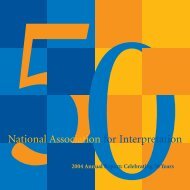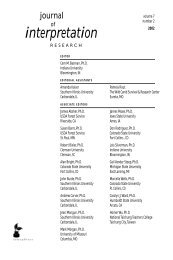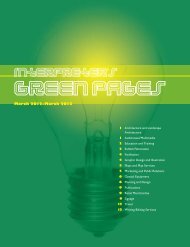interpretation
Volume 15, Number 1 - National Association for Interpretation
Volume 15, Number 1 - National Association for Interpretation
You also want an ePaper? Increase the reach of your titles
YUMPU automatically turns print PDFs into web optimized ePapers that Google loves.
e v a l u a t i n g s i g n e f f e c t i v e n e s s<br />
H2: Treatment 2 (Narrative) attention capture and holding power > Control (Existing<br />
Park Message).<br />
H3: Treatment 3 (Humor & Salient Beliefs) attention capture and holding power ><br />
Control (Existing Park Message).<br />
H4: Treatment 4 (Telegraphic Title) attention capture and holding power > Control<br />
(Existing Park Message).<br />
Sampling<br />
Sampling was carried out over four weekend and three weekday periods at the three<br />
locations across the nine-week study period, as follows. We conducted four two-hour<br />
sessions per treatment at Upper Pines and Wilderness Trailhead, and three sessions<br />
per treatment at Curry Village. More sessions occurred at Upper Pines and Wilderness<br />
Trailhead than at Curry Village due to lower visitation. Campground and trailhead<br />
sessions were conducted in the morning when most visitors were preparing to leave<br />
the campground and hikers were just starting on the trail. Curry Village subjects were<br />
sampled during the afternoon when many visitors were registering for their stay.<br />
Observational data – Attention to signs. Observational data were collected for<br />
more than 100 hours at each location. The observer was positioned unobtrusively in<br />
a place from which the sign was visible and it could be determined whether passersby<br />
ignored, glanced at, or viewed the sign for an extended time period. Every person who<br />
approached to a point at which the sign was within his or her field of vision (closer<br />
than five feet) was recorded. If groups approached the sign, one member was randomly<br />
selected for observation. At busy times it was not always possible to observe every group;<br />
if others passed while the observer was tracking one group, they were not included. For<br />
each individual observed, gender, group size, and the presence or absence of children<br />
was documented to determine if these variables impacted attention-paying behavior.<br />
Attention to the sign was monitored and recorded either as “ignored” the message<br />
(no overt attention directed at the sign), “glanced” at the message (physically oriented<br />
toward the sign, but for two seconds or less), or “extended viewing” (stopped to read the<br />
message for more than two seconds). Those who viewed for extended periods were timed<br />
until they ceased looking at the sign.<br />
Interviews. Interspersed with observation sessions, semi-structured oral interviews<br />
were conducted with campground and trail visitors to obtain in-depth information<br />
about reactions to signs. The intent was to achieve balanced sampling between people<br />
who stopped for extended viewing and people who did not stop. Of the 163 visitors<br />
interviewed, about 50% stopped to read the message beyond two seconds, and the<br />
remaining half glanced at or ignored the message. An attempt was made to select every<br />
third or fourth visitor who had been observed, depending upon the amount of traffic<br />
flow during the observation session.<br />
The interviews began with questions asking visitors about their immediate<br />
reactions to the sign. Then visitors were asked whether the signs and their content<br />
seemed familiar or new. Further questions asked what visitors liked and disliked about<br />
the signs. The interview concluded with questions about how long visitors had been in<br />
the park and prior visits they had made, to ascertain whether familiarity affected visitor<br />
response to signs.<br />
Interviews were tape-recorded and transcribed verbatim. Using standard content<br />
v o l u m e 15, n u m b e r 1 23












